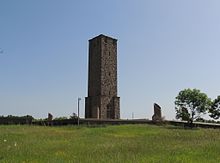Gazimestan
Газиместан Gazimestani | |
 Gazimestan monument | |
 | |
| 42°41′26″N 21°7′25″E / 42.69056°N 21.12361°E | |
| Location | 5 km (3.1 mi) from Pristina, Kosovo |
|---|---|
| Designer | Aleksandar Deroko |
| Type | memorial, tower |
| Material | stone |
| Height | 25 m (82 ft) |
| Completion date | 1953 |
| Dedicated to | fallen Serbian soldiers at the Battle of Kosovo (1389) |
Gazimestan (Serbian Cyrillic: Газиместан, Serbian pronunciation: [ɡaziměstaːn], Albanian: Gazimestani) is the name of a memorial site and monument commemorating the Battle of Kosovo (1389), situated about 6–7 kilometres southeast of the actual battlefield, known as the Kosovo field. Gazimestan is accessible from the Pristina–Mitrovica highway, on a 50-metre-high hill above the plain, ca. 5 km north-west from Pristina. Every year, on Vidovdan (St. Vitus Day), 28 June, a commemoration is held by the monument, which in later years is also covered by an image of Prince Lazar, who led the Serbian army at the Battle of Kosovo.
Name[edit]
Gazimestan derives from the Arabic word ghazi 'hero, holy warrior' and the Serbian word mesto 'place'.[1]
History[edit]
Commemorations of the Battle of Kosovo at Gazimestan became more prominent and significant after the founding of the Kingdom of Serbs, Croats and Slovenes in 1919. A memorial park was constructed there after 1924.[2]
In 1989, on the 600th anniversary of the Battle of Kosovo, Serbian president Slobodan Milošević gave the famous and controversial speech Gazimestan speech, which has been called the starting point of the disintegration of Yugoslavia.[citation needed]
In 1997 the site was declared a cultural heritage of Serbia.[3] Large numbers of Serbians gather at the monument to commemorate Vidovdan. Violent protests by the Kosovo Albanian community have sometimes occurred during these gatherings.[4]
Monument[edit]
The Gazimestan monument was designed by Aleksandar Deroko, in the shape of a medieval tower, and built in 1953 on the order of the Serbian communist government.[5] The monument connected the "fighting tradition" of the Serbian people with the modern-day victory of the communist revolution. It is designed in the form of a medieval tower. The inside bears inscriptions with excerpts from folk poetry about the Battle of Kosovo.[6] Its design prompted a debate on architectural style: modernist critics, represented by the writer Živorad Stojković, saw it as incompatible with the times and reminiscent of the architectural style favored under the Kingdom of Yugoslavia.[6] Later, the Kosovo curse, which was recorded by the 19th-century folklorist Vuk Karadžić and which curses any Serb who does not fight at Kosovo, was also included in Cyrillic letters on the monument.[7] Nowadays, the monument is under constant guard by police and is surrounded by a high fence.[8] It has been claimed that the monument was deliberately targeted for bombing and damaged during the NATO bombing of Yugoslavia; however, an investigation by academics András Riedlmayer and Andrew Herscher published in 2001 found that any damage observed "was not consistent with anything that could have been caused by an aerial attack." The staircase inside of the monument was reportedly damaged by an explosive after the Kosovo War.[9]
-
Vidovdan 2009
-
Vidovdan 2013
See also[edit]
References[edit]
- ^ Ejdus 2020, p. 59, n. 15.
- ^ Marković 1989, p. 129.
- ^ "Gazimestan". Spomenici. Republic of Serbia. Archived from the original on 2016-03-04. Retrieved 2017-04-25.
- ^ Wollentz 2020, pp. 177–178.
- ^ Wollentz 2020, p. 167.
- ^ a b Čolović 2016.
- ^ Wollentz 2020, p. 168.
- ^ Wollentz 2020, p. 169.
- ^ Wollentz 2020, pp. 191–192.
Sources[edit]
- Čolović, Ivan (2016). "The Kosovo Myth". Yuhistorija.com. Retrieved 9 August 2020.
- Ejdus, Filip (2020). "The Construction of Kosovo as Serbia's Ontic Space". Crisis and Ontological Insecurity. Cham: Palgrave Macmillan. pp. 39–63. doi:10.1007/978-3-030-20667-3_3. ISBN 978-3-030-20666-6.
- Marković, Dragan (1989). "Svečanosti na Gazimestanu o Vidovdanu između dva svetska rata" (PDF). Etnološke sveske. 10: 127–134.
- Wollentz, Gustav (2020). Landscapes of Difficult Heritage. Palgrave Studies in Cultural Heritage and Conflict. Cham: Palgrave Macmillan. ISBN 978-3-030-57124-5.




